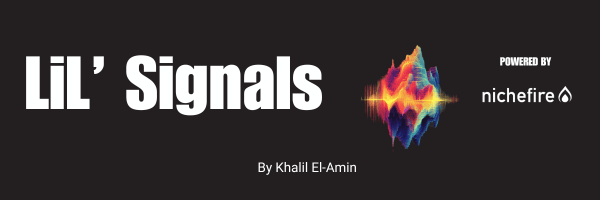- Lil' Signals
- Posts
- Lil’ Signals: When Tariffs Become Culture Wars
Lil’ Signals: When Tariffs Become Culture Wars
How trade policy is fueling a cultural reset—from price shocks to brand strategy shifts.

👋🏽 Hey There
Lil’ Signals is your go-to newsletter for decoding the cultural currents shaping our world.
Powered by Nichefire’s cutting-edge technology, we break down trends, tell compelling stories, and share actionable insights on how to tap into the power of cultural listening.
Stay ahead of the curve—one signal at a time.
In this edition, we’re diving into how politics isn’t just shaping policy—it’s reshaping culture. From President Trump’s newly implemented reciprocal tariffs to the global ripple effects now hitting consumer behavior, trade has officially entered the cultural chat.
But this isn’t just about price tags or trade deficits. It’s about how inflation, economic anxiety, and nationalist messaging are influencing what people buy, how brands respond, and what stories are resonating across industries.
In a moment where cost of living and global supply chains are in flux, marketers, strategists, and cultural operators need to see beyond the economic headlines. They need real-time visibility into how culture is responding—and where the next opportunities are emerging.
That’s why in this week’s Cultural Listening 101, we’re breaking down the latest Firesearch upgrade—giving teams the ability to trace trend origins, click into live sources, and go deeper with one-click related searches. It’s cultural intelligence, fully unlocked.
Because in 2025, understanding what’s trending is just the start. Acting on it? That’s where the signal turns into strategy.
Let’s dive in!! 🎯
Table of Contents

StoryTime
Storytime: Decoding the Politics of Trade, Global Ripple Effects, and Cultural Shifts at Home

Let’s be real: politics doesn’t just shape policy, it shifts culture.
From how we shop to how we feel about the future, every decision at the top filters down into cultural currents.
Over the past quarter, political tension in the U.S. has given rise to a cultural climate that feels anxious, reactive, and increasingly uncertain.
At the center of this new wave: President Trump’s reintroduction of reciprocal tariffs, a sweeping policy designed to rebalance trade by taxing imports from countries with significant trade surpluses against the U.S.
Dubbed “Liberation Day” by the administration, April 2 marked the signing of an executive order enforcing a minimum 10% tariff on all U.S. imports, with rates reaching up to 50% for countries like China, Vietnam, Mexico, and Germany.
LIBERATION DAY RECIPROCAL TARIFFS 🇺🇸
— The White House (@WhiteHouse)
8:38 PM • Apr 2, 2025
The rationale? Fairness.
The fallout? Far more layered.
These tariffs are more than just economic measures; they’re setting off cultural alarms.
What Are Reciprocal Tariffs, Really?
The logic behind reciprocal tariffs is simple in theory: If Country X taxes American goods at 25%, the U.S. will do the same in return.
But in practice, these new tariffs are calculated based on trade deficits, not actual tariff rates, a methodology many economists criticize as flawed and potentially inflammatory.
Still, for the Trump administration, it’s a reset: a signal to foreign nations and domestic industries alike that the U.S. is reasserting economic control.
Signal 1: What It Means for the U.S. Consumer
The average American shopper won’t need a white paper to feel the impact.
These tariffs hit at the core of what we import and what people consume every day:
•Technology: Smartphones, tablets, and laptops from China and Southeast Asia are already climbing in price. That next iPhone might carry a $150–$300 premium.
•Vehicles & Auto Parts: Cars built in Mexico or Germany could see sticker price increases between $1,500 to $3,000, according to analysts at Kelley Blue Book.
•Consumer Goods: Apparel, furniture, toys, and home essentials from Vietnam and India mean higher costs for back-to-school shopping, holiday gifts, and everyday essentials.
Tariffs are built to send a message to foreign governments, but American households hear them loudest.
What to Watch For:
•Delayed inventory due to global supply chain renegotiations.
•Increased demand for generic and private label brands.
•A growing cultural conversation around financial literacy, resilience, and prioritizing “needs vs. wants.”
Signal 2: Global Consumers Will Feel It Too
The U.S. doesn’t trade in a vacuum.
As tariffs go up, foreign governments are already preparing countermeasures.
European tariffs on American whiskey, beef, and technology are expected to follow.
And emerging economies that depend on affordable U.S. imports may find themselves priced out or supply-starved.
It’s a global price echo one that could tighten markets, slow growth, and shift sourcing strategies worldwide.
Culturally, we may see increased skepticism of globalization and a return to nationalism in branding across multiple countries.
Signal 3: Culture Follows the Coin
As inflation climbs, culture adjusts. When money tightens, mindsets shift.
Here’s what’s already emerging:
•Localism Gets a Boost: “Buy American” and regional sourcing will evolve from niche narratives to dominant ones. Expect brands to double down on provenance, transparency, and community roots.
•Minimalism Goes Mainstream: The cultural aesthetic of “less but better” is growing. Financial wellness content, frugality hacks, and mindful consumption are gaining traction on platforms like TikTok, YouTube, and Reddit.
•DIY and Upcycling Resurgence: Consumers are rediscovering how to stretch what they already own from home repairs to thrifting to crafting.
For marketers, culture creators, and strategists, this is a critical inflection point: are we responding to sticker shock or building strategies for long-term relevance?
Signal 4: Are There Any Opportunities?
Yes. But they require a cultural lens.
1. Reshoring Momentum: The push for domestic manufacturing is real. Sectors like automotive, textiles, and consumer electronics are already seeing investment spikes. A PwC report confirms that reshoring is gaining real traction.
2. SMBs & Challenger Brands: Smaller, more nimble companies can position themselves as honest, local, and aligned with the consumer’s new priorities. Brands that emphasize trust and proximity over global dominance will win favor.
3. Creators & Cultural Voices: There’s cultural capital in speaking to shared sacrifice. Storytelling that addresses economic anxiety, celebrates community resilience, or reimagines consumption can drive engagement and loyalty.
Final Word
This isn’t just a trade war, it’s a cultural reset.
Yes, reciprocal tariffs bring tension.
They increase costs and uncertainty.
But they also force reflection on how we consume, what we value, and who we trust.
Whether we frame this moment as economic hardship or a collective rebalancing is up to us.
The brands that speak to resilience, the communities that unite around shared sacrifices, and the leaders who solve for scarcity, they’re the ones who’ll rise above the noise.
At the end of the day, trade policy may be political, but culture is personal.
Let’s keep the conversation going.
Let’s explore the power of culture, one signal at a time.

Cultural Listening 101
Cultural Listening 101: Firesearch Gets a Power Boost
This week, we’re spotlighting a powerful upgrade to one of our most used tools inside the Nichefire platform: Firesearch.
If you’ve ever used Firesearch, you know it’s designed to help you surface emerging narratives and cultural trends fast. But now it just got smarter.
With the latest update, Firesearch doesn’t just list the top narratives around a topic. It now shows exactly where those trends are happening. Think of it like cultural X-ray vision. You can now see the source signals, news articles, social posts, and content clusters that are driving the conversation. And better yet? You can click directly into them.
Let’s say you see a trend like “Make America Healthy Again.” One click takes you to a breakdown of why that narrative is gaining traction, whether it's RFK Jr.'s campaign, policy debates on SNAP benefits, or a wider conservative wellness movement. It's fast, intuitive, and way more actionable.
Even better: There's now a button to “Request Related Trends.” Instead of copy-pasting queries to dig deeper, Firesearch builds a connected thread for you. That means in seconds, you can explore how MAGA health messaging connects to soda bans, workforce narratives, or SNAP reforms, all in one seamless flow.
Here’s why that matters:
Firesearch was already great at giving you the what. Now, it’s giving you the why and letting you chase the so what with confidence.
Why This Upgrade Matters
Whether you’re heading into a brainstorm, campaign planning, or a strategy session, this tool is a must. Type in anything from a social movement to a product keyword and Firesearch now arms you with:
A snapshot of trending narratives.
A list of reliable sources driving the story.
One click access to deep dive trends and connected insights.
And because it sits on top of Nichefire’s always-on, cross-platform data, you’re not just guessing what’s happening in culture, you’re seeing it as it happens.
In short, the new Firesearch isn’t just a listening tool. It’s your cultural intelligence engine supercharged.
Until next time, stay curious and stay ahead.
Reach out for a walkthrough and start making cultural listening work for you.
See you next week for another installment of Cultural Listening 101.
Thank you for subscribing to Lil’ Signals.
If you enjoyed this post or know someone who may find it useful, please share it with them and encourage them to subscribe: https://lilsignals.beehiiv.com/p/lil-signals-decoding-culture-one-insight-at-a-time?draft=true

Content Engines
I want to see what You can create!
Got a cool AI-generated video?
Creative Experiment?
A bold Idea?
Share it with us!
Reply to this email with your best creations, and let’s see who’s leading the AI content revolution. 📤✨

Top Cultural Trends
Stay Ahead with Nichefire
In this new section, we’re diving into Nichefire’s unique tools to explore the top cultural trends shaping our world.
This week, we break down key insights from the Movements Matrix, spotlighting high-growth and emerging trends across 47 cultural categories
Spot Emerging Trends: Discover niche opportunities before they hit the mainstream.
Actionable Insights: Leverage cultural data to make faster, smarter decisions.
Comprehensive View: Analyze trends across 47 pre-trained cultural categories.
Lil’ Surfing 🌊
Just interesting articles I find on “The Internets” 😜

💬 Your journey into the world of cultural insights starts here!
Thank you for being part of the Lil’ Signals community. Together, we’ll decode the world, one signal at a time.
Reply